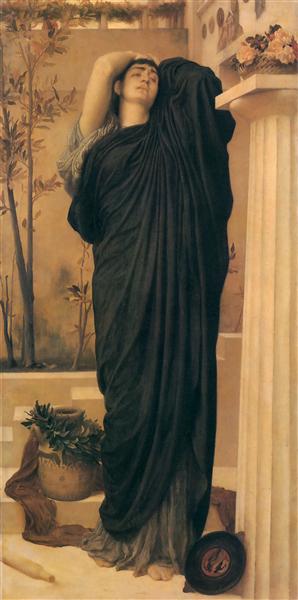Descrizione
Frederic Leighton's Electra at the Tomb of Agamemnon (1868) is a magnificent example of how Victorian art lies at the intersection of mythology and emotion. Depicting a dramatic scene from Greek myth, this painting highlights Leighton's ability to combine deep narrative with refined technical execution. At the center of the composition is Electra, who, in an evocative state of mournful longing, stands at the tomb of her father, Agamemnon, a mythical king whose death sets off a chain of vengeance and tragedy.
Electra’s depiction is pivotal. Her figure is dressed in a light tunic, which at once suggests a connection to the past and accentuates her emotional vulnerability. The tension of the moment is palpable: the expression on her face, marked by sadness and deep longing, allows the viewer to empathize with her pain. Electra appears to be at a crossroads, caught between the suffering of losing her father and the burden of seeking justice for his death.
The use of colour in this painting is also noteworthy. Leighton uses a palette that evokes the melancholic atmosphere of the myth. The warm tones of Electra's clothing contrast with the darker, more sombre colours of the tomb, suggesting a struggle between life and death, past and present. The light that illuminates the scene is strategically used to draw attention to Electra's figure, highlighting her loneliness and her connection to the place where her father rests.
The composition is carefully balanced. The central figure of Electra is surrounded by a series of architectural and natural elements that frame her sadness. The elegant shape of the tomb, covered by a blanket of leaves and shadows, offers a sense of permanence and desolation, in contrast to the fragility of Electra's figure. Through this spatial arrangement, Leighton manages to communicate not only the protagonist's pain, but also the inescapable reality of loss.
This work is a testament to Leighton's academic style, a style that sought to revive classical traditions through a contemporary approach. His interest in the human figure and emotional narrative is reflected in this work, placing it within the rich tradition of 19th-century historical painting. Attention to detail and formal beauty within a narrative context are aspects that unite "Electra at the Tomb of Agamemnon" with other contemporary works, such as those of his Pre-Raphaelite colleagues, who also explored themes of Romanticism and human suffering.
Throughout his career, Frederic Leighton has dedicated himself to capturing moments of great emotional depth through his characters, and this work is no exception. Electra at the Tomb of Agamemnon is not only a stunning visual representation; it is an invitation to reflect on grief, revenge, and the echoes of history that resonate throughout time. The painting remains relevant, inviting the viewer to connect with the sense of loss and longing that Electra represents, making it a work that transcends its historical context to speak of human suffering in all its universality.
KUADROS ©, a famous painting on your wall.
Hand-made oil painting reproductions, with the quality of professional artists and the distinctive seal of KUADROS ©.
Painting reproduction service with satisfaction guarantee. If you are not completely satisfied with the replica of your painting, we will refund 100% of your money.

